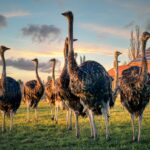A concise Q&A outlining what has been publicly reported
Universal Ostrich Farms in Edgewood, British Columbia became the centre of national attention after a confirmed outbreak of highly pathogenic avian influenza, also known as H5N1. The situation sparked months of protests, court hearings, and public debate as the Canadian Food Inspection Agency (CFIA) worked to contain the virus and enforce national disease-control policy.
This Q&A explains what happened on the farm, why more than 300 ostriches were culled, and what the broader implications are for animal health, public safety, and farming practices in Canada.
1. What happened on the BC ostrich farm, and why were more than 300 birds culled?
Highly pathogenic avian influenza (H5N1) was confirmed in the flock. The outbreak led to the death of 69 ostriches, which triggered the Canadian Food Inspection Agency (CFIA) to order the cull of more than 300 birds.
2. Where was the farm located, and who owned it?
The farm is Universal Ostrich Farms in Edgewood, British Columbia. It is owned by Karen Espersen and Dave Bilinski, and their daughter, Katie Pasitney, has spoken publicly on behalf of the family.
3. What led to the Canadian Food Inspection Agency (CFIA) stepping in?
The CFIA intervened after confirming multiple cases of H5N1 on the farm. Their stated goal was to protect public and animal health and reduce risks to the poultry sector and the Canadian economy. The agency said the poultry industry represents about 6.8 billion dollars domestically and supports export markets worth about 1.75 billion dollars.
4. Is H5N1 dangerous to humans, and can people contract it?
H5N1 can infect humans, but it is rare. Infection usually requires very close, direct contact with sick or dead birds or their secretions. When humans do contract H5N1, the illness can be severe, but human-to-human transmission is extremely uncommon and has not been sustained. Canada has had only one confirmed human case on record.
5. How was the culling carried out, and who made the decision?
The CFIA ordered the depopulation and said it was carried out by professional marksmen under veterinary supervision. The agency explained that, after consulting experts, this method was considered the most humane and controlled option for a flock of this size.
6. Were there any warning signs before the outbreak?
There were ongoing respiratory and flu-like symptoms among the birds, and 69 ostriches died before the cull order was enforced.
7. How common is avian influenza among ostriches or other large birds?
Ostriches can potentially shed the virus even when they do not show clear symptoms. The CFIA noted that birds appearing healthy may still carry and spread H5N1, which creates a risk of further transmission, especially in contact with wildlife. They also said that keeping the flock alive could pose a risk of viral mutation.
8. What measures are being taken to prevent the spread of the virus to nearby farms?
The CFIA reported that all disposal and cleanup work followed strict biosecurity and containment procedures to limit any chance of spread.
9. What happens to the carcasses after a mass cull like this?
The CFIA handled the carcass disposal on site using approved biosecurity procedures. Observers were not able to see the full process because the area was restricted and screened off.
10. Are there any ongoing investigations or public concerns about how the situation was handled? What does this incident reveal about the risks of large-scale farming of non-native species in Canada?
The situation has led to protests and public debate, with some people questioning the role of government agencies and the policies used to control disease outbreaks. It has also raised broader concerns about the challenges of farming non-native species in Canada, especially during infectious disease events.
As the situation concludes, it serves as a reminder of how quickly animal-health emergencies can unfold and how complex the response can be for everyone involved. It also highlights the importance of clear communication, strong biosecurity practices, and ongoing monitoring to protect both wildlife and farmed animals in Canada.
At CharityAxess, our goal is to make important developments easier to understand and follow. Summaries like this help bring clarity to complex situations so people can stay informed and aware of issues that may impact local communities and nonprofit work across Canada.
About the Writer: Abirame Shanthakumar is a volunteer writer with CharityAxess who is passionate about animal welfare, environmental issues, and global development. She has written on topics such as engineering, sustainability, and poverty alleviation, using her writing to highlight the role of charities in driving positive change. In her spare time, Abirame enjoys reading, writing fiction, and spending time outdoors with a good cup of coffee in hand. Her work with CharityAxess reflects her strong belief in advocacy, compassion, and storytelling for impact.
Image of Ostriches by Albrecht Fietz from Pixabay





